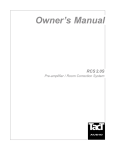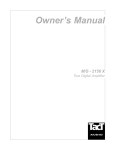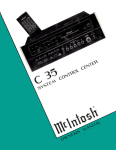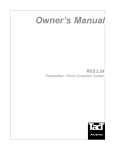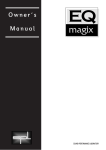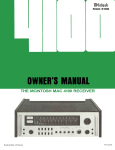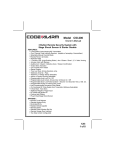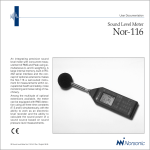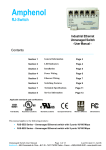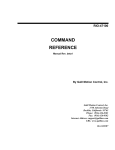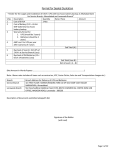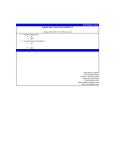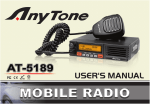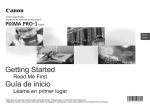Download TacT Audio RCS 2.2 XP User's Manual
Transcript
Owner’s Manual RCS 2.2 XP Preamplifier / Dynamic Room Correction System WARNING TO REDUCE THE RISK OF FIRE OR ELECTRIC SHOCK, DO NOT EXPOSE THIS APPLIANCE TO RAIN OR MOISTURE. CAUTION RISK OF ELECTRIC SHOCK DO NOT OPEN CAUTION: TO REDUCE THE RISK OF ELECTRICAL SHOCK, DO NOT REMOVE COVER. NO USER-SERVICEABLE PARTS INSIDE. REFER SERVICING TO QUALIFIED PERSONNEL. The exclamation point within an equilateral triangle is intended to alert the user to the presence of important operating and maintenance (servicing) instructions in the literature accompanying the product. The lightning with arrowhead symbol within an equilateral triangle is intended to alert the user to the presence of “Dangerous Voltage” within the product’s enclosure that may be of sufficient magnitude to constitute a risk of electrical shock to a person. Tact Audio 3 Important Safety Instructions 1. Read these instructions entirely before installing or operating this equipment. 2. Keep these instructions. 3. Heed all warnings. 4. Do not use this equipment near water or allow it to become wet. 5. Do not block any ventilation openings. Install in accordance with the manufacturer’s instructions. CAUTION 6. Do not install near any heat sources such as radiators, heat registers, stoves, or other appliances (including amplifiers) that produce heat; doing so may damage the unit and present a fire hazard. 7. Do not defeat the safety purpose of the polarized or grounding-type plug. A polarized plug has two blades with one wider than the other. If the provided plug does not fit into your outlet, consult an electrician for replacement of the outlet to one that is polarized. To protect against electrical shock, match the wide blade of the polarized plug to the wide slot in the outlet and fully insert the plug. 8. Protect the power cord from being walked on or pinched, particularly at plugs, convenience receptacles, and the point where they exit the equipment. Do not use this unit with a damaged cord or plug. 9. Only use attachments/accessories specified by the manufacturer. 10. Unplug this equipment during lightning storms or when unused for long periods of time. 11. Refer all servicing to qualified service personnel. Cleaning and Maintenance 1. 2. Always unplug the unit from the electrical outlet before cleaning. Do not use abrasive cleaners. Simply wipe the exterior with a clean soft cloth. A small amount of nonabrasive cleaner may be used on the cloth to remove excessive dirt or fingerprints. The >note< operation. 4 Tact Audio symbol indicates information very useful or essential to daily Acknowledgments © 2006 Tact Audio Corporation. All rights reserved. No part of this document may be reproduced or transmitted in any form or by any means, electronic, mechanical, photocopying or other wise, without the prior written consent of the Tact Audio Corporation. The information contained in this document is subject to change without notice. Registration IMPORTANT! Please record your serial number here for future reference. You will need this for future upgrades or should you ever require service on your RCS 2.2 XP Preamplifier. RCS 2.2 XP serial number: _____________________ Optional modules installed: DAC-1 analog output / main-channels: _______________________ DAC-2 analog output / subwoofers: _______________________ ADC analog input: _______________________ Tact Audio 5 TABLE OF CONTENTS Safety instructions 4 Acknowledgments/Registration 5 Unpacking the RCS 2.2X 7 Introduction 6 Tact Audio CAUTION 8 Dynamic Room Correction 10 Automatic Room Correction 12 Connecting the RCS 2.2X 20 Front Panel Controls 25 Remote Control 26 Front Panel Display Main screen 28 28 MAIN menu MODE menu ADC menu DOUT FS menu POL menu TEST menu DISPLAY menu COMM menu AMP menu OPTIONS menu LOCK menu MSR menu INFO menu 30 31 32 33 34 34 35 36 37 38 39 40 40 Room Correction Menu LEVELS menu DELAYS menu NAMES menu CRO menu MSR menu 41 42 42 43 43 44 Parametric EQ Menu LINK option TABLE menu 46 47 48 UNPACKING THE RCS 2.2 XP Carefully remove the RCS 2.2 XP and accessory kit from the carton and visually check for shipping damage. Contact both the shipper and TacT Audio immediately if the unit shows any sign of damage from rough handling. All TacT Audio equipment is carefully inspected before leaving our factory. KEEP SHIPPING CARTON AND PACKING MATERIALS for future use or in the unlikely event that the unit needs servicing. If this unit is shipped without the original packing, damage could occur and void the warranty. Accessories You should find the following items in the accessory kit: • • • • • • • • • Operating voltage 1 AC mains cord 1 RJ11 data cable 1 RJ11-to-RS232 adapter 1 15’ RS232 cable CD-ROM with RCS software Measurement microphone Remote control 2 AAA batteries This manual The RCS 2.2 XP is designed with an automatic switching power supply. It will operate on 65-265 volts at 50-60 Hz. No external settings are required. The RCS 2.2X has three operating modes: OFF AC mains power is cut off, either via the rear panel mains switch, or by unplugging it from the wall outlet. STANDBY The unit is powered but all outputs are muted and the display is off. The unit uses very little current and is “idling” or “sleeping”. Use the remote or front panel “STANDBY” button to toggle between ON and STANDBY. ON Everything is powered and ready to go. Tact Audio 7 INTRODUCTION Congratulations on your purchase of your RCS 2.2 XP. You have now acquired the most advanced stereo Preamplifier / Room Correction System ever developed! The RCS 2.2 XP has four times the processing power of the famous TacT RCS 2.0 and even better AD and DA conversion. This now combined with new features and a more user-friendly interface takes TacT Audio’s room correction to new heights. The RCS 2.2 XP has no noise and extremely low distortion, yielding CAUTION amazingly transparent accurate sound. Every effort has been made to make this preamplifier the best that money can buy. Add to this the latest evolution of TacT Audio’s room correction technology and the result is absolutely staggering. Room Correction System TacT room correction technology has been praised by the press all around the world. Comments like “Wholesale improvement in sound quality” have become a standard phrase for reviewers describing the results that can be achieved with TacT’s room correction. Now we have taken room correction technology even further, not only in terms of processing power, but also in terms of the measurement and correction systems. The measurement is now done with a triple pulse for each acquisition. This increases the measurement resolution in both the time and frequency domains. Correction resolution is now four times higher than found in the original RCS 2.0. Separate Subwoofer Control One of the most exciting features of the RCS 2.2 XP is its separate subwoofer output. The RCS 2.2X P can be used with one or (preferably) two subwoofers. An electronic crossover can be set with a frequency between 60 and 400 Hz and a slope between 12 dB/octave and 60 dB/octave to split the audio signal between the main and subwoofer outputs. The correction software aligns the sub-woofer(s) with the main speakers in the time domain and in the frequency domain, for completely seamless integration surpassing even the best single-box systems. With the RCS 2.2 XP, you can add subwoofers to an existing High End speaker system for substantial sonic improvements. Preferably, the subwoofers should be placed in the corners behind the main speakers. Corner placement of the subwoofers will yield much higher efficiency with significantly reduced low-frequency distortion. But more importantly, the transfer of energy from the sub to the listening position will be much more direct, resulting in vastly improved impulse response. The room correction system will easily compensate for the frequency response variations of the subs introduced by corner placement. It will delay the main speakers for perfect time alignment to within 1/8 of an inch. The RCS 2.2 XP offers you the opportunity to add subwoofers to a system and improve the transient response tremendously at the same. This contrasts sharply with the normal result of adding subwoofers to a system: slow – undefined bass with lots of frequency and time behavior problems. If the separate subwoofer outputs are not used, then the RCS 2.2X will use all the processing power on the main speakers. 8 Tact Audio Introduction Modular design The internal layout of the RCS 2.2 XP is completely modular. All of the expensive components such as DSP’s, D/A and A/D converters are a plug-in type and are placed on a motherboard. This allows for easy and inexpensive future upgrades. Even the rear-panel, including the sockets, can be exchanged to accommodate future interfaces. True Upgradeability The front-panel and DSP’s are 100% software driven, and improvements or new features can be loaded through the RS232 port with firmware upgrades. It is our policy to offer software upgrades at no cost, and we therefore encourage you to fill out and submit the enclosed registration card by fax or email (info@tactaudio. com). Tact Audio 9 DYNAMIC ROOM CORRECTION Dynamic Room Correction (DRC) ® is new technology developed by Tact Audio Inc. over past two years. This groundbreaking brings the science and art of Room Correction, and specifically Tact room correction products, to yet another level. When we introduced our first RCS system (the Tact-2.2 in the late 90’s) we were fully aware that we were embarking on a long term research process in the new exciting field of room acoustics correction. As a result of this research effort we CAUTION brought to the market products such as Tact-2.0 S two channel RCS preamp, the Tact-2.2 X two channel preamp with RCS on two main and two subwoofer channels, and the TCS MKII ten channel theater correction system. All these systems offer RCS technology not found in any other product on the market. Our continued research combined with enormously valuable feedback from our customers has resulted in this new technology that we named Dynamic Room Correction (DRC)®. Why do we call it Dynamic Room Correction (DRC)? The reason we call it DRC is that the target curve used to compute correction filters dynamically changes with the master level control. In another words, for every 0.1 dB of level change the system uses a new target curve to compute room correction filters. What makes this dynamic is that all computations and adjustments are done on the fly without any interruption to the music you listen to. Why do we need Dynamic Room Correction (DRC)? It is well known fact that humans do not here all frequencies at the same level. It is also known that our ears are more sensitive to frequencies between 2000 and 5000 Hz than to frequencies bellow 2000 Hz and above 5000 Hz. In addition to this our hearing sensitivity changes with sound pressure level (SPL). This human hearing property was first discovered and experimentally confirmed by Fletcher and Munson at Bell Laboratories in 1933 and later refined by Robinson and Dadson in 1956. Their work resulted in a family of equal loudness curves (contours), widely known as Fletcher-Munson equal loudness curves. A sample of Fletcher-Munson loudness curves is shown in the figure bellow. On the graph there are 12 curves numbered from 0 to 110. These numbers represent the loudness level in phons. A Phon is a unit used to describe the loudness level of a given sound. The reason for introducing the loudness unit is that two sounds with the same SPL (dB) do not necessarily have the same perceived loudness. Phon is equal to SPL in decibels at 1000 Hz. For example, 80 phons means as loud as 80 dB, 1000 Hz tone. Equal loudness curves represent the SPL that different frequencies need to have in order to be perceived as two tones of equal loudness. For example, a 200 Hz tone at SPL of 50 dB will have the same perceived loudness as a 1000 Hz tone at SPL of 40 dB. In this case both 200 Hz and 1000 Hz tones have a loudness of 40 phons, and they both belong to the 40 phons equal loudness curve. As it can be seen from the graph, in comparison to frequencies between 2000 and 5000 Hz, it is intrinsically harder for us to hear very low frequencies (below a few hundred Hz) and to a lesser extent very high frequencies (above 7000 Hz). At higher listening levels this difference gradually becomes smaller and smaller and curves become flatter. 10 Tact Audio Traditional Tact room correction systems use one target curve that allows for full range 20-20,000 Hz room corrections. Once selected, the same target curve (same set of correction filters) was used at all listening levels. This approach did not take in account the fact that our sound perception, as described by FletcherMunson curves, is frequency and level dependent. Many of our customers have realized this fact and they have used the nine correction presets (available on all our RCS products) to program 2.0 S, 2.2 X and TCS MKII with nine different target curves each corresponding to a different listening level. In this way they were able to take into account the equal loudness curve effect by switching to new target curves as the master level changes. Thus for a number of reasons it is clear that we need a room correction system that will perform room acoustics correction and at the same time dynamically change the target curve (correction filters) as the system listening level changes. How does it work? Dynamic Room Correction (DRC) offers a very sophisticated way of handling a multi target curve approach to solving equal loudness curve problem. The system is based on one reference target curve and eight additional target curves called dynamic target curves. The reference target curve is used to perform basic reference room correction. Dynamic target curves are labeled 0, -6, -12, -18, -24, -30, -36 and –42 dB and are combined with the reference target curve to obtain the final target curve used to calculate correction filters. For example, if the master level reads –10.3 dB (89.6 on the relative readout) the system will use the –6 dB and the –12 dB dynamic target curves and by interpolation will calculate a target curve corresponding to –10.3 dB. After that the system will combine the 10.3 dB target curve with the reference curve to obtain the final target curve that is then used to calculate the correction filters. New correction filters are loaded into the signal path as the music is playing and the new correction takes effect in a split of a second. The same process repeats again for any new master level setting. Tact Audio 11 AUTOMATIC ROOM CORRECTION Tact-2.2 XP can now perform room correction automatically from the 2.2 XP front panel user interface, without the need for an PC software. The automatic room correction feature is designed to perform the entire room correction process without using a PC interface. The Tact-2.2 XP has sufficient DSP processing power to perform room measurement, crossover filter design, target curve generation and correction filter calculation. The entire process is controlled CAUTION from the 2.2 XP front panel DRC-RCS menu. Target curve and crossover filter adjustments can be made on the fly while the music is playing. Users can, for example, specify a boost at low frequencies or a roll-off at high frequencies. Values of the ‘low’ and ‘high’ frequencies can also be adjusted. PC based room correction requires that the 2.2 XP is connected to the RS232 port of a PC. PC software is used just as a GUI (graphical user interface) to provide the user with a graphical presentation of the correction process. After the room response measurement is completed, the room frequency response for all measured channels can be displayed on the screen. Crossover filters and actual correction filters can be viewed. The displayed graphs provide valuable information that helps users design their own optimum target curve. The Tact-2.2 XP memorizes two sets of target curves: computer generated and automatically generated target curves. When the automatic feature is turned OFF, the 2.2 XP will use a computer generated set of target curves. When the automatic feature is turned ON, the 2.2 XP uses target curves generated by the 2.2 XP front panel automatic correction feature. When the 2.2 XP is connected to a PC and the automatic feature is enabled, automatically generated target curves will be uploaded into the RCS/DRC screen. The curves can than be saved or modified. Modified curves can than be loaded back into the 2.2 XP. However, the uploaded curves will not take effect until the automatic feature is disabled. Any target curve uploaded to 2.2 XP is saved as a PC generated target curve and takes effect only when the automatic feature is disabled. In another words, if a target curve is to be modified by the PC software, the automatic correction feature has to be disabled. This following describes the automatic room correction process for all 2.2 XP operating modes. 12 Tact Audio 2.2 Mode This operating mode assumes a stereo system consisting of two main channels and two subwoofers. To select 2.2 mode from the main screen, click on the MENU button, and then select the MODE menu. In MODE menu, click on the STEREO 2.2 option. This will select 2.2 mode and will display it on top of the screen (1) Fig.1. Fig. 1. Mode menu. 2.2 mode selection is displayed in the upper left corner (1). To perform 2.2 mode automatic room correction go through the following steps: 1. Correction Bypass. Place 2.2 XP in correction bypass mode. You can place 2.2 XP in bypass mode by pressing on the BP remote control button or by using the front panel controls. Fig. 2. Tact-2.2 XP main screen. Note a ‘*’ next to BP. It indicates that BP – bypass mode is selected. 2. Crossover Filters Off. Make sure that crossover filter option is set to OFF. It is important that all measurements are performed without any crossover filtering. If your loudspeakers have built in electronic crossover filters, make sure that they are disabled. If crossover filters could not be disabled, set the subwoofer crossover filter to its highest frequency and main channel to its lowest cut off frequency. To disable crossover filters enter the RCS-DRC menu and select the CROON(OFF) option in Fig.3 to enter Crossover screen Fig. 4. Fig. 3. RCS-DRC screen. Tact Audio 13 CAUTION Fig. 4. Crossover menu. CRO: OFF indicates that crossover filters are disabled Crossover filters can be turned OFF from the front panel crossover menu (Fig. 4). Place the screen cursor over the CRO: ON menu option and then press the enter button (click) until it displays CRO: OFF, and then click on SET option.. Please note that any change made on this screen does not take effect until you click on the SET option. Click on the MENU button to go back to the DRC-RCS screen, Fig. 3. 3. Measurements. To perform room response measurements, select the MSR menu option to display the measurement screen (Fig. 5). Fig. 5. Measurement screen. The 2.2 XP is factory configured to measurement parameters as displayed in Fig. 5. The MSR MIC CAL option should be turned ON and the MIC FILE field should display the microphone serial number as printed on your microphone MSR MIC CAL. When this option is set to ON, the room correction algorithm will apply the microphone calibration file to the measurement data. When this option is set to OFF, the microphone calibration file is ignored. MIC FILE. This field displays the microphone file name used to perform microphone calibration. The microphone calibration file data is saved in 2.2 XP internal memory. For more details on how to transfer microphone calibrations file to 2.2 XP memory, please refer to the Microphone section of the PC software manual. AVG This is a very important measurement parameter. It equals the number of measurements that are averaged prior to being saved. The averaging process reduces the effects of random environmental noise. Typical Average values go from 10 to 30. 14 Tact Audio DELAY. If you do not want to be in the room while measurement is in progress, set this parameter to a few seconds to allow you to exit the room. For example, if DELAY = 10 the system will wait for 10 seconds before it starts pulsing. PULSE. This parameter sets the relative level of the output measurement pulse. Minimum level is 1% and maximum level is 100%. FILE. Use this option to assign a File number to the measurement you are just about to perform. At the end of the measurement process, the measurement data for all four channels will be saved in the selected File number. Tact-2.2 XP supports up to seven measurement files. In another words you can save up to seven different measurements in 2.2 XP internal memory. Use L, R, SL and SR options to select (enable) a channel for measurement. Channels are labeled as L for left, R for right, SL for subwoofer left and SR for subwoofer right channel. Selected (enabled) channels are marked by a rectangle. To select or deselect a channel place the cursor over desired channel and press ENTER button. In most cases, factory presets are optimum and users can proceed directly with peforming actual measurements. To initiate the room measurement process, click on the START button. The following screen will be displayed: Fig. 6. Microphone calibration and measurement screen After the measurements are completed, click on the EXIT option and then click on the MENU button to go back to the DRC-RCS screen (Fig. 3). At any time during the measurement process you can click on the CANCEL option to cancel the process. After the measurement is completed or the measurement was canceled, the CANCEL option changes its name to EXIT. Tact Audio 15 4. Enable automatic room correction. In the DRC-RCS screen (Fig. 3), select correction preset 1. Make sure that crossover filters are enabled and proper crossover frequency is selected. Crossover filters can be adjusted at any time even after you enable the automatic feature. Click on the AUTO-OFF menu option to enter the Auto Correction screen (Fig. 5). Note that in bypass mode the AUTOOFF(ON) menu option is not displayed. CAUTION Fig. 5 Auto Correction screen. In the Auto Correction screen click on the AUTO-OFF menu option to display AUTO-ON and then click on the SET option to activate automatic room correction. In a split of a second the 2.2 XP will calculate target curves based on LF, HF, crossover filter selection parameters and measurement data as saved in measurement file 1. You are ready to perform your first listening test. Use LF parameters to add gain or attenuation at frequencies bellow the frequency as displayed in LF parameter bloc (1). Use HF parameters to add gain or attenuation to frequencies above the frequency as displayed in HF parameter block (2). In this way you can shape target curves to match your specific listening needs. Please note that changes you make on this screen do not take effect until you click on the SET option. 16 Tact Audio 2.1 Mode This operating mode assumes a stereo system consisting of two main channels and one subwoofer. To select 2.1 mod from the main screen, click on the MENU button to enter the main menu screen and then select the MODE menu. In the MODE menu click on the STEREO 2.1 option. This will select 2.1 mode and display it on top of the screen (1). Fig. 6. Mode menu. 2.1 mode selection is displayed in the upper left corner (1). The rest of the procedure is the same as in 2.2 mode. Note the change in the measurement screen in Fig. 7. The Tact-2.2 XP will automatically select channels for measurements based on the mode selection. Fig. 6. Mode menu. 2.1 mode selection is displayed in the upper left corner (1). The rest of the procedure is the same as in 2.2 mode. Note the change in the measurement screen in Fig. 7. The Tact-2.2 XP will automatically select channels for measurements based on the mode selection. Tact Audio 17 2.0 Mode This operating mode assumes a stereo system consisting of two main channels only. To select 2.0 mode from the main screen, click on the MENU button to enter main menu screen and then select the MODE menu. In the MODE menu click on STEREO 2.0 option. This will select 2.0 mode and display it on top of the screen (1). CAUTION Fig. 8. Mode menu. 2.0 mode selection is displayed in the upper left corner (1). The rest of the procedure is the same as in 2.2 mode. Note the change in the measurement screen in Fig. 9. The Tact-2.2 XP will automatically select channels for measurements based on the mode selection. Fig. 9. Measurement screen for 2.0 mode. Note that SR does not have a rectangle around indicating that this channel is not set for measurement. In 2.0 mode only the Left and Right channels will be measured. At the end of the measurement process the Subwoofer Left and Subwoofer Right measurement data will be set to 0 dB flat response. 18 Tact Audio Tact Audio 19 RCS 2.2 XP CONNECTIONS Digital input The RCS 2.2 XP has 5 digital inputs: • 3 S/PDIF (RCA) • 1 AES/EBU (XLR) (TosLink) • 1 Optical (T CAUTION All of the digital inputs support PCM audio data with sampling rates from 32 kHz to 96 kHz /16-24 bits. However, the AES/EBU and RCA/coaxial input also support 192kHz. Digital output 1 main channels The RCS 2.2 XP has 3 digital outputs for the main channels: • 1 S/PDIF (RCA) • 1 AES/EBU (XLR) (TosLink) • 1 Optical (T All outputs are 24-bits at 44.1, 48, 88, 96 or 192 kHz sampling rates (TosLink does not support 192kHz). The output sampling rate is set in the “DOUT” menu. The main channel output is used for your main speakers or for Mid/High-frequencies when used with subwoofers. Connect one of these outputs to a TacT digital amplifier or external DA converter. 20 Tact Audio RCS 2.2 XP Connections Digital output 2 subwoofers The RCS 2.2XP has three digital outputs for subwoofer(s) : • 1 S/PDIF (RCA) • 1 AES/EBU (XLR) (TosLink) • 1 Optical (T All outputs are 24-bits at 44.1, 48, 88, 96 or 192 kHz sampling rates. The output sampling rate is set in the “DOUT” menu. (TosLink does not support 192kHz) The sub output is for your subwoofer(s) and can be configured for either mono or stereo. Use the “MODE” menu to set the appropriate output mode 2.0, 2.1, or 2.2. Connect one of these outputs to a TacT digital amplifier or external DA converter. Optional modules The RCS 2.2 XP is designed to accommodate virtually any input and output needed without adding extra cost for features certain users might not use. There are therefore 3 optional modules that can be installed: • ADC-converter module for analog inputs such as Tuners, Cassette decks, VCRs etc. • DAC-converter module for main channels, needed when the RCS 2.2 XP is used with traditional analog amplifiers • DAC-converter module for subwoofer(s), needed when the RCS 2.2 XP is used with analog self-powered subwoofer(s) These modules are based on the latest 24-bits/192 kHz state-of-the-art technology and offer performance far beyond that of most stand-alone converters. Due to the modular design of the RCS 2.2 XP, these modules can be added at any time or exchanged if upgrades should become available. Tact Audio 21 RCS 2.2 XP Connections Analog input (optional ADC module) The RCS 2.2 XP has 4 stereo analog inputs when the optional ADC module is installed: • 3 analog stereo single ended (RCA) • 1 analog stereo balanced (XLR) CAUTION NOTE: The optional ADC module is required for analog inputs. NOTE: A/D conversion is always performed at 24-bits/192 kHz. Analog output main channels (optional DAC module) The RCS 2.2 XP has 2 stereo analog outputs for the main channels when the optional DAC-MAIN module is installed: • 1 analog stereo single ended (RCA) • 1 analog stereo balanced (XLR) NOTE: The optional DAC module is required for analog outputs. 22 Tact Audio RCS 2.2X Connections Analog output subwoofer(s) (optional DAC module) The RCS 2.2 XP has 2 analog outputs for subwoofer(s) when the optional DACSUB module is installed: • 1 analog stereo single ended (RCA) • 1 analog stereo balanced (XLR) NOTE: The optional DAC module is required for analog outputs. Microphone input Connect the supplied measurement microphone to the “Mic Input” connector when taking a room measurement for dynamic room correction. CAUTION: To avoid damage through static discharge, we strongly recommend that you turn off the RCS 2.2 XP via the rear panel mains switch before connecting the microphone. Tact Audio 23 RCS 2.2 XP Connections RS232 interface ports The RCS 2.2 XP has two RS232 interface ports: • INPUT • AUX Use the “INPUT” port for communication with your personal computer. CAUTION Use the “AUX” port to connect to TacT digital amplifiers or to daisy chain with multiple RS232 components. AC mains input & mains switch Connect the RCS 2.2 XP to the AC mains wall socket. Use the mains switch to turn power ON or OFF. CAUTION: Use the supplied IEC mains cable, or a 3-prong grounded cable 24 Tact Audio FRONT PANEL CONTROLS The front panel controls on the RCS 2.2 XP will allow you to access and control all menu settings. Digital Input Selector Standby Mute Input Display Master Volume Volume Level Menu Navigation/ Analog Input Selector Standby Use the “STANDBY” button to toggle between Standby mode and ON. The display will indicate Standby mode by displaying a small green light in the left side of the display. When the unit is placed in Standby mode all user settings are saved. Master volume The master volume is controlled by turning the “TacT wheel”. The green digits on the left side will change as you turn the wheel - this is your master volume level indicator. (The wheel sensitivity, max. volume etc. can be set in the “OPTIONS” Mute Use the “MUTE” button to mute or un-mute during playback. The volume level indicator will switch to “--” in Mute mode. You can still adjust the master volume while the unit is in Mute mode - the volume level indicator will briefly indicate the level, then switch back to the “--” mute indicator Digital input selector Press the “DIGITAL” DIGITAL button to select the digital input. This is a toggle switch, and DIGITAL” by pressing it multiple times it will toggle through all of the five digital inputs. The selected input will be displayed in the input display portion of the display. Analog input selector Press the “ANALOG “ ” button to select the analog input. This is a toggle switch, and by pressing it multiple times it will toggle through all of the four analog inputs. The selected input will be displayed in the input display portion of the display. NOTE: Please note that the optional ADC module is required for analog inputs. Menu Navigation/Enter Press the “MENU” button to access the front panel menu system. Use the navigational buttons to navigate the options and select with the middle “Enter” button . NOTE: The remote and front panel controls are disabled whenever a Personal Computer is connected and the Room Correction or ParEQ software is running. To enable the remote and front panel controls press and hold down the “DIGITAL” and “ANALOG” input selector simultaneously. Tact Audio 25 REMOTE CONTROL The remote control is used to access the front panel display controls and menus. CAUTION 1 2 3 4 5 7 6 9 10 11 12 26 Tact Audio 8 Remote Control 1 - STANDBY The STANDBY button will either turn the RCS 2.2 XP on or will place it int standby mode. When in standby mode, the unit is placed into a low power “idling” state. The standby button is also used to save changes that were made in the menu parameters. By placing the unit into standby mode the current menu settings are 2 - DIGITAL The DIGITAL button will scroll sequentially, allowing for selection of one of the 5 digital inputs. 3 - ANALOG The ANALOG button will scroll sequentially, allowing for selection of one of the 4 analog inputs. 4 - CORRECTION block The CORRECTION block consists of 10 buttons. The buttons are numbered from 1 to 9 and one BYPASS. Pressing the BYPASS button will place room correction into bypass mode – no correction. Pressing any of the remaining nine buttons will engage the corresponding room correction preset. 5 - MENU The MENU button will switch the front panel display from the status screen to the MAIN menu screen. 6. VIDEO The VIDEO button is inactive with this unit. 7. UP The UP navigation button is used to select menu options and/or change their values. 8. DOWN The DOWN navigation button is used to select menu options and/or change their values. 9. LEFT The LEFT navigation button is used to select menu options and/or change their values. 10. RIGHT The RIGHT navigation button is used to select menu options and/or change their values. 11. ENTER The ENTER button will select the menu option currently marked by the blinking cursor or will enter an edited parameter. 12. VOLUME Block The VOLUME block consists of three buttons. The “MUTE” button will mute/un-mute all enabled channels. The “UP” button will increase the master volume level. The “DOWN” button will decrease the master volume level. Tact Audio 27 FRONT PANEL DISPLAY The main screen is displayed when the RCS 2.2 XP is powered on. CAUTION To move the cursor indicator use the front panel or remote control navigation buttons. To select an option press the “ENTER” button. 1 Correction preset selection 2 EQ preset selection 3 Master level in dB 4 Correction menu option 5 Parametric EQ menu option 6 Output sampling frequency indicator 7 Input sampling frequency indicator 8 RCS 2.2 XP operating mode 9 Master level in dB 10 Mono mode indicator. Correction preset selection To select one of the nine correction presets or to bypass them use the “LEFT” or “RIGHT” navigation buttons to position the cursor over CR (1). Once the cursor is positioned over CR (1) press the “ENTER” button. The system will then display a pull down list containing all presets. Use the “UP” and “DOWN” navigation buttons to point to the desired correction preset and then press the “ENTER” button. This action will engage the selected preset and will display the new selection in the CR box (1). Once the cursor is positioned over CR (1) you can also select a correction preset by pressing one of the ten buttons located in the block labeled “CORRECTION” on the remote control. The 2.2 XP will display a < > next to the selected presed indicating that the preset was loaded. * EQ preset selection To select one of sixteen parametric EQ presets or to bypass them use the “LEFT” or “RIGHT” navigation buttons to position the cursor over EQ (2). Once the cursor is positioned over EQ (2) press the “ENTER” button. The system will then display a pull down list containing all presets. Use the “UP” and “DOWN” navigation buttons to point to the desired EQ preset and then press the “ENTER” button. This action will engage the selected preset and will display the new selection in the EQ box (2). Once the cursor is positioned over EQ (2) you can also select a correction preset by pressing one of the ten buttons located in the block labeled “CORRECTION” on the remote control. The 2.2 XP will display a Note: with the remote control you can only select the first nine presets. To select the rest you must use front panel controls. 28 Tact Audio Front Panel Display Master Level Indicator This field displays the system master level in dB. It is calculated as relative gain (displayed from 0 to 99.9) minus 99.9 plus GAIN (as set in the OPTIONS menu). For example, if the GAIN option is set to 3 dB and the front panel master level display reads 87.5 dB, this field will display 87.5 - 99.9 + 3.0 = -9.4 dB. Correction menu option Move the cursor to the DRC-RCS (4) option and press the “ENTER” button to enter the main dynamic room correction menu. Parametric EQ menu option Move the cursor to the PAR EQ (5) option and press the “ENTER” button to enter the main parametric EQ menu. Note: An EQ preset must be enabled from the main screen for the PAR EQ menu to be active. If the EQ preset is set to “BP”, the PAR EQ controls are disabled. Output sampling frequency indicator This displays the currently selected output sampling frequency. The output sampling frequency is can be modified in the “OUT-FS” general menu option. Input sampling frequency indicator This displays the sampling frequency of the currently selected digital input. The RCS 2.2 XP will automatically detect input signal presence and display its sampling frequency. RCS 2.2 XP operating mode This displays the systems operating mode. The operating mode can be modified from the “MODE” main menu option. MONO mode indicator When the MONO option in the MODE menu is set to ON, this field displays an ‘M’. If the MONO option is set to OFF, this field is not visible. Tact Audio 29 Front Panel > Main Menu MAIN menu The main menu screen lists all of the RCS 2.2 XP general menus. Access the main menu through the menu button on the front panel or the remote control. CAUTION To highlight a menu option use the navigational buttons. To enter a highlighted option press the “ENTER” button. MODE menu sets operation mode for the 2.2XP - use to specify 2.2, 2.1, 2.0 modes or the MONO option. ADC menu use to set the analog input sensitivity. DOUT-FS menu use to set the Left/Right and Sub Left/Right digital output sampling frequency. POL menu use to set the channel polarity as well as the absolute polarity. TEST menu allows for the pink noise output test. DISPLAY menu use to set various display options. COMM menu use to set the 2.2 XP device address. AMP menu use to enables/disables Tact digital amplifier control. OPTIONS menu use to set various 2.2 XP options. LOCK menu allows for locking certain parts of the user interface. MSR screen displays microphone calibration information. INFO screen displays firmware version. Note: The MSR screen is now accessed through the First Screen DRC-RCS correcion screen option. 30 Tact Audio Front Panel > Main Menu MODE menu Use this menu to set the RCS 2.2 XP to one of four operating modes. To highlight an option use the navigational buttons. To enter a highlighted option press the “ENTER” button. STEREO 2.2 This mode produces 4 output signals. Left, Right, Left SUB, and Right SUB STEREO 2.1 This mode produces 3 output signals. Left, Right and one SUB signal. In this mode the SUB signal is mono and is output to both the Left SUB and Right SUB outputs. STEREO 2.0 This mode produces 2 output signals. This is standard two channel stereo mode. In this mode there is no signal at the subwoofer outputs. MONO This option can be set to ON or OFF. When set to ON the system will output the same signal for both the Left and Right channels. Tact Audio 31 Front Panel > Main Menu ADC menu (optional ADC module) The RCS 2.2 XP can be equipped with a state of the art Analog to Digital Converter (ADC module optional) . To further enhance the converter’s performance, the system offers two selectable gain values for the ADC input stage, 0dB or -6dB. These values can be assigned to each input independently. CAUTION To select an option use the “UP” and “DOWN” navigation buttons and to change its value press the “ENTER” button to toggle between the -6dB and 0 dB selections. Analog input sensitivity can be set seperately for each input. If 0 dB is selected, the maximum input voltage for that particular input will be 4.4 Vrms. If -6 dB is selected, the maximum input voltage for that particular input is 2.2 Vrms. This menu option has no effect on the digital inputs. NOTE: The optional ADC module is required for analog inputs. 32 Tact Audio Front Panel > Main Menu DOUT-FS menu The RCS 2.2 XP is equipped with a sample rate converter on each digital output. Each output can independently be set to 44.1, 48, 88, 96 and 192 KHz sampling frequencies. To set the sampling frequency for digital outputs 1 or 2, use the “LEFT” or “RIGHT” navigational buttons to highlight the desired option (44.1, 48, 88, 96, 192 kHz) and then press the “ENTER” button to make the selection. Output 1 refers to the Left/Right channel output. Output 2 refers to the Sub Left/Right channel output. The RCS 2.2 XP is equipped with separate sample rate converters at each Left/ Right and Sub Left/Right output. The Left/Right and Sub Left/Right outputs can be programmed to have different sampling frequencies. NOTE: This menu does not affect the analog output sampling frequency and has no effect on the analog outputs. Tact Audio 33 Front Panel > Main Menu POL menu Use this screen to set individual channel polarity and absolute channel polarity. CAUTION Each channel can be set to “+” (0) or “-” (inverted). To select an option use the “UP” and “DOWN DOWN Tttt” navigational buttons and to change its value press the “ENTER” button to toggle between a “+” or “-” setting. If all channel options are set to ‘+’ or all channel options are set to ‘-’, all output signals will come out in phase. If one channel is set to ‘+’ and another channel is set to ‘-’ their respective output signals will be out of phase. ABS POL option (absolute polarity) will flip the phase on all channels. TEST menu The test menu is designed to allow for a quick system check. When engaged it will produce pink noise on all selected channels. When a channel is set to “Y” pink noise will be heard from that channel when “Run Test” is selected. To highlight an option use the the “UP” and “DOWN” navigational buttons and then press the “ENTER” button to make your selection. After all selections are made, highlight the “Run Test” option and hold down the “ENTER” button to produce the test signal. The test tone will stop when the “ENTER” button is released. Press the “MENU” button to exit this menu. 34 Tact Audio Front Panel > Main Menu DISPLAY menu The display menu allows for control over the front panel display appearance. To select an option use the “UP” or “DOWN” navigational buttons and then use the “LEFT” and “RIGHT” buttons to change the value. 1. Timeout This option is used to turn the front panel timer “ON” or “OFF”. When this option is “ON” the front panel timer will count the number of seconds specified by the Timeout in sec option, and then turn the display OFF or dim it to a level specified by the OFF Brightness option. 2. Timeout in sec This option is used to set the number of seconds that the display will remain on before turning off or dimming after accessing an option on the front panel display. This parameter can be set to a value from 3 to 30 seconds. For example, if it is set to 15 seconds the front panel timer will count to 15 seconds and will then turn the display OFF or dim it to a level specified by the OFF Brightness option. 3. ON Brightness This option determines the front panel brightness after the unit is powered on or an option on the front panel display is accessed. This parameter can be set to any value between 1 and MAX(16). 4. OFF Brightness This option determines the front panel brightness after timeout has expired. This parameter can be set to any value between OFF (0) and MAX(16). Tact Audio 35 Front Panel > Main Menu COMM menu Use this screen to set the 2.2 XP device address. CAUTION This menu has only one option, Address. Address can be set to any number between 1 and 255. This parameter is used by PC programs to identify the 2.2 XP. This feature allows for multiple Tact units to be controlled by the same RS232 link. The RS232 speed is set to 57.6 Kb. To change the system device address highlight the “Address” option and then using the “LEFT” and “RIGHT” navigational buttons select the desired system address. The RCS 2.2X is shipped with the default address set at 1. NOTE: If you change the device address make sure that you select the appropriate device address in the RCS 2.2X Room Correction software. 36 Tact Audio Front Panel > Main Menu AMP menu The AMP menu is designed to allow the RCS 2.2 XP to interface with the TacT line of digital amplifiers. The RCS 2.2 XP can control multiple digital amplifiers. This setting should be ENABLED only if you have a Tact digital amplifier attached to the RCS 2.2 XP. To change the settings use the “UP” and “DOWN” navigational buttons to highlight the option and then press the “ENTER” button to change the setting. If the L & R option is set to DISABLE, the Left/Right channel will operate in normal mode. The mater level control will affect both the digital and the analog output signal. If the L & R option is set to ENABLE, the master level control has no effect on the Left/Right analot or digital output signal. The Left and Right channel signal will output the maximum signal level, which is equivalent to the 99.9 setting on the volume display. The front panel master level information (relative read out, 0-99.9) will be broadcast to all digital amplifiers connected to the RS232 AUX connector. In this case, volume control is implemented in Tact digital amplifiers. The same applys to the SUB L & R option. For example, one amplifier can be used for main left and right channels and the second one can be used for the left and right subwoofer channels. If two TacT digital amplifiers are connected, both options should be set to ENABLED. If one Tact digital amplifier is connected only one option should be set to ENABLED and the other one should be set to DISABLED. Enable should only be set for the output that uses Tact digital amplifiers. NOTE: When a TacT digital amplifier is controlled by the RCS 2.2 XP, all of the amplifier’s front panel and IR controls are disabled. Use the RS232 port and/or daisy chain to link the components. CAUTION: The AMP setting should only be set to ENABLED if you have Tact amplifiers connected to the RCS 2.2 XP. When the AMP option set to ENABLED both the analog and the digital output will output a full level signal regardless of the RCS 2.2 XP master volume setting. If you do not have Tact amplifiers connected to your system you will not be able to control the output level from the RCS 2.2 XP volume control. The output is sent at its maximum level and can result in damage to your speakers. Tact Audio 37 Front Panel > Main Menu OPTIONS menu The options menu allows for control of the systems maximum signal level, signal detection threshold (SDTH), wheel speed, and remote control. CAUTION To select an option highlight it using the “UP” and “DOWN” navigational buttons. To modify a selected option use the “LEFT” and “RIGHT” buttons. Max Level This option controls the system’s maximum signal level. For example, if this option is set to -3.0 dB, the volume control can not go above -3.0 dB. The minimum value is -99.9 and the maximum value is equal to the value of the GAIN parameter. Detection This option sets the signal detection threshold. If the absolute value of the Left or the Right channel signal goes above this threshold the red signaling dot will be displayed on the front panel bellow the master volume display. This feature can be used to indicate signal presence on either channel or to indicate near clip condition. To use it as a signal presence indicator set the Detection to a value close to -90.0 dB. To use it as near clip indicator set the Detection to a value close to 0.0 dB. This paramete can be set anywhere from -99.9 dB to 0 dB. One step above 0 dB will turn this feature OFF. NOTE: This light does not indicate clip condition. When the parameter is set to bellow 0 dB and the red LED on the frontpanelturnson,itisonlyanindicationthattheinputaudiosignal hasreachedthethresholdlevel.Itdoesnotindicatedinputoroutput signal clipping. Wheel This option sets the wheel sensitivity. The wheel sensitivity can be set to between 1 and 10 or to “OFF” to disable the Wheel for volume control. The lower the setting the slower the volume increases and the higher the setting the faster the volume increases with each turn of the Wheel. Remote This option enables and disables the remote control. Once the remote control is disabled the unit can only be controlled from the front panel. GAIN 38 Tact Audio Front Panel > Main Menu LOCK menu Use this screen lock certain areas of the front panel user interface. To select an option highlight it using the “UP” and “DOWN” navigational buttons. To modify a selected option use the “LEFT” and “RIGHT” buttons. 1. LOCK MENU When this option is set to YES all Main Menu options except LOCK and INFO are disabled 2. LOCK DRC-RCS When this option is set to YES the user can not change current correction presets and can not enter the DRCRCS screen. 3. LOCK PAR EQ When this option is set to YES the user can not change current ParEq presets and can not enter the PAR EQ screen. Tact Audio 39 Front Panel > Main Menu INFO menu Use this screen to verify the versin of firmware that is installed on your RCS 2.2 XP. This screen also provides TTact Audio’s web address and phone number. Pleae feel free to contact us should you require any furthe information from us - we would love to hear from you! CAUTION 40 Tact Audio Front Panel > Correction Menu CORRECTION menu Access the CORRECTION menu by selecting DRC-RCS from the RCS 2.2 XP first screen. To highlight a menu option use the navigational buttons. To enter a highlighted option press the “ENTER” button. LEVELS menu Use to set individual channel level. DELAYS menu Use to set individual channel delay time and the AUTO/ MANUAL delay option. NAMES menu Displays the correction preset symbolic names and allows for name based correction preset selection. PRESET option This option allows for correction preset selection. Place the screen cursor over this option and use the UP DOWN buttons to display the desired preset. Press the ENTER button to make a selection. The active preset has a < > displayed next to it. * DRC option Use this option to turn dynamic room correctin ON and OFF. When this option is changed the 2.2 XP will recalculate and engage new correction based on the selection of this parameter. CRO option This indicates the status of the corssover package. The menu it leads to is used to set 2.2 XP crossover parameters. MSR menu This menu is used to perform room response measurements for Automatic Room Correction. See p.12 for an explanation of Automatic Room correction. Tact Audio 41 Front Panel > Correction Menu LEVELS menu Use this menu to set individual channel level settings. CAUTION Use the UP and DOWN buttons to place screen cursor on desired option and then use the LEFT and RIGHT buttons to adjust individual channel level settings. Each output signal level is determined by the channel level, as set in this menu, the master level control, and system GAIN as set in OPTIONS menu. DELAYS menu Use this menu to set individual channel delay settings. Use the UP and DOWN buttons to place screen cursor on desired option and then use the LEFT and RIGHT buttons to adjust individual channel level settings. Place screen cursor over field (1) and press ENTER to switch between AUTO and MANUAL delay time setup. When AUTO is selected the delay time is determined by the measurement algorithm during the measurement process. Measured delay time is saved with each measurement in the selected measurement file. These values can be manually changed but once the correction preset is re-selected, changes made to the delay time will be lost. To use manually set delay times set the field (1). Tact-2.2 XP keeps track of delay times set for both AUTO and MANUAL delay option. 42 Tact Audio Front Panel > Correction Menu NAMES menu Use this screen to view the symbolic names assigned to each preset number. Use the UP and DOWN buttons to place the screen cursor on desired option. Press the enter button to engage the selected correction preset. CRO menu Use this screen to set RCS 2.2 XP crossover parameters. To highlight a menu option use the navigational buttons. To select a highlighted option press the “ENTER” button. 1. Use this option to set low-pass filter order. This option can be set from 1 to 24. 2. Use this option to set the low-pass filter cutoff frequency. Minimum frequency is 40 Hz and maximum frequency is 500 Hz. 3. Use this option to set the high-pass filter order. This option can be set from 1 to 12 4. Use this option to set the high-pass filter cutoff frequency. Minimum frequency is 40 Hz and maximum frequency is 500 Hz. 5. Place the cursor on this option and press the ENTER button to turn the crossover filters ON or OFF. 6. Click on this option to engage selected crossover filters. 7. Displays the currect correction preset. Tact Audio 43 Front Panel > Correction Menu MSR menu Use this menu to perform room response measurments directly from the front panel, without an external computer interface. CAUTION Y Your 2.2 XP is factory configured to measurement parameters as displayed above. The MSR MIC CAL option should be turned ON and tjhe MIC FILE field should display the microphone serial number as printed on your microphone. MSR MIC CAL. When this option is set to ON, the room correction algorithm will apply the microphone calibration file to the measurement data. When this option is set to OFF, the microphone calibration file is ignored. MIC FILE. This field displays the microphone file name used to perform microphone calibration. The microphone calibration file data is saved in 2.2 XP internal memory. For more details on how to transfer microphone calibrations file to 2.2 XP memory, please refer to the Microphone section of the PC software manual. AVG This is a very important measurement parameter. It equals the number of measurements that are averaged prior to being saved. The averaging process reduces the effects of random environmental noise. Typical Average values go from 10 to 30. DELAY. If you do not want to be in the room while measurement is in progress, set this parameter to a few seconds to allow you to exit the room. For example, if DELAY = 10 the system will wait for 10 seconds before it starts pulsing. PULSE. This parameter sets the relative level of the output measurement pulse. Minimum level is 1% and maximum level is 100%. FILE. Use this option to assign a File number to the measurement you are just about to perform. At the end of the measurement process, the measurement data for all four channels will be saved in the selected File number. Tact-2.2 XP supports up to seven measurement files. In another words you can save up to seven different measurements in 2.2 XP internal memory. Use L, R, SL and SR options to select (enable) a channel for measurement. Channels are labeled as L for left, R for right, SL for subwoofer left and SR for subwoofer right channel. Selected (enabled) channels are marked by a rectangle. To select or deselect a channel place the cursor over desired channel and press ENTER button. 44 Tact Audio Front Panel > Correction Menu In most cases, factory presets are optimum and users can proceed directly with peforming actual measurements. To initiate the room measurement process, click on the START button. The microhpone calibration and measurement screen will be displayed: After the measurements are completed, click on the EXIT option and then click on the MENU button to go back to the DRC-RCS screen (Fig. 3). At any time during the measurement process you can click on the CANCEL option to cancel the process. After the measurement is completed or the measurement was canceled, the CANCEL option changes its name to EXIT. NOTE: For instructions on how to initiate Automatic Room Correction, please go to p.12. Tact Audio 45 Front Panel > Parametric EQ Menu PARAMETRIC EQ menu This menu is used to control the 12 band parametric equalized. This menu is accessed through the PAR EQ option on the RCS 2.2X first screen. If Par Eq preset is set to BP - bypass the following screen will be displayed: CAUTION In this screen only two options are enabled: PRESET and LOCK. 46 Tact Audio Front Panel > Parametric EQ Menu PARAMETRIC EQ menu When a Par Eq preset other that BP is selected this screen can have two forms: one with the LINK option set to YES and the other with the LINK option set to NO. When the LINK option is set to NO the following screen is displayed. When the LINK option is set to YES the following screen is displayed. To highlight a menu option use the navigational buttons. To select a highlighted option press the “ENTER” button. 1. TABLE menu option. To enter the TABLE menu screen highlight and select either the LEFT & RIGHT or the LEFT or RIGHT selections and press ENTER button. The available selection is determined by the setting of the LINK option as axplained bellow. 2. LINK menu option. This option determines if the left and right channels are linked to the same EQ filters. If NO is selected the channels are not linked and each channel has a separate set of EQ filters. If YES is selected the channels are linked and there will be only one set of filters used for both the left and right channels. To change the LINK setting highlight the current LINK selection and press ENTER button to toggle between the YES and NO selections. 3. PRESET menu option. This option allows for EQ preset selection. The < > character indicates the current preset. To select a new preset highlight the PRESET option and use the UP and DOWN buttons to scroll through the available presets. When the desired preset is displayed press the ENTER button to select it. 4. LOCK menu option. This option is used to lock the current parametric EQ preset. When set to YES the parametric EQ preset cannot be changed. To change the LOCK setting highlight the current LOCK selection and press the ENTER button to toggle between the YES and NO selections. 5. Active Preset display. This displays the preset that is currently loaded into the system. This is not a selectable menu option. * Tact Audio 47 Front Panel > Parametric EQ Menu PARAMETRIC EQ menu This is an example of the linked parametric EQ filter table. Its display allows for adjustment of all filter parameters: Level, center frequency and filterwidth given in octaves. The filter parameters will be applied globally to both the left and right channels. This scren is accessed through the LINK menu option on the PAR EQ menu screen. CAUTION To change a parameter first highlight it and press ENTER button. Then use the LEFT and RIGHT navigational buttons change the parameter value. 48 Tact Audio 1. Indicates that this table is for linked filters 2. Current parametric EQ preset. 3. Filter order. For more filters scroll down the list. Front Panel > Parametric EQ Menu PARAMETRIC EQ menu The following is an example of an un-linked ParEQ table featuring the left channel parametric EQ filter table. Its display allows for the adjustment of all filter parameters: Level, center frequency and bandwidth and they will be applied independently to the left channel. There is an analogous table for the right channel. You can enter the right channel table from the previous menu, the PAR EQ screen. To change a parameter first highlight it and press ENTER button. Then use the LEFT and RIGHT navigational buttons change the parameter value. 1. Indicates the left or right channel filter table. 2. Current parametric EQ preset. 3. Filter order. For more filters scroll down the list. Tact Audio 49 TacT Audio, Inc. 201 Gates Road Unit G, Little Ferry – New Jersey 07643, USA Phone: +1 201 440 9300 – Fax: +1 201 440 5580 – Email: [email protected] www.tactlab.com


















































